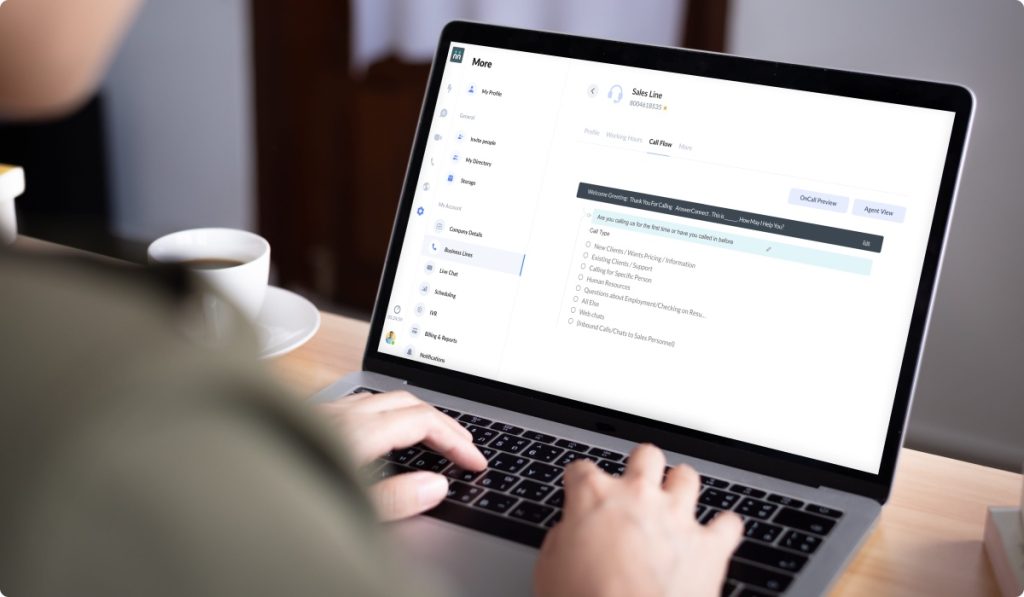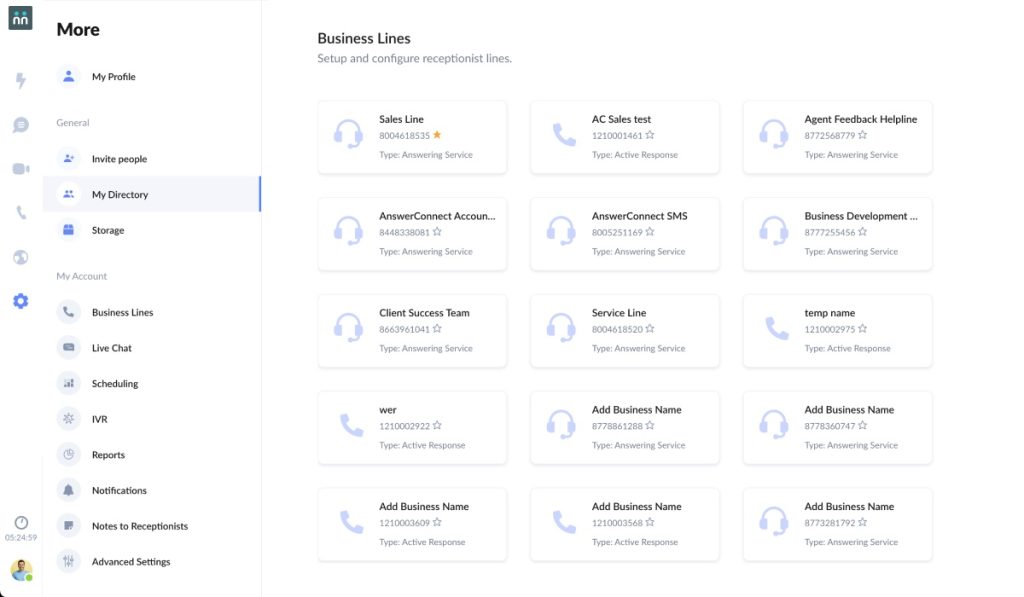If you have a live agent answering calls for your business – you’ll likely want to have a script for a receptionist answering phone calls as a top priority! At AnswerConnect We’ve got you covered. We’ll take you through a few simple steps to help you understand how to make a script within AnswerConnect’s own interface.
Here’s what will be covered in this blog 📚
- What is a call script
- How to customise call scripts with AnswerConnect’s
- Quick tips for your call scripts
- Call script examples for your receptionists
Before we get started here are a few key terms to help you get to grips with some key terminology.
Keyword Glossary
- Call flow – The script used by your virtual receptionists to answer calls to your business. Your call flow denotes the various answers your virtual receptionists could give based on the caller’s questions.
- Live Chat Support – An AnswerConnect service wherein virtual receptionists engage visitors to your website through a chat widget.
- Client services team – Your AnswerConnect support representatives. When you sign up, you’ll work with our client services team to make any changes to your account that you can’t make yourself.
- Time-of-Day scripting – A service that enables you to give callers custom responses based on the time they contact your business.
- Repeat – Repeats enable your virtual receptionists to repeatedly dial specific team members until they get an answer.
Now that you’re familiar with the terminology, you’re probably eager to start (and who could blame you?). If you work with a reputable answering service, you’ll be provided with the option to customise your call answering script, so your calls will be handled in a way that suits you. With AnswerConnect, that’s part and parcel of what we do.
We take time to learn about your business. We discuss your call requirements, typical customer base, and overall business goals. But to configure your script for maximum value, it’s worth exploring the terminology, purpose and possibilities around your call-handling service. Our Head of Customer Experience Robert Phillips says
“Our first and foremost priority is to understand what makes our client’s callers tick. We want our agents to be an extension of your team – to speak the way you do, provide the support you do. It’s so important that your caller’s first impressions are consistent and of the standard you expect. That’s why at AnswerConnect, our focus is always to understand your business right from the start.”

What is call scripting?
Call scripting, AKA your call flow, refers to the lines your receptionists use when answering customer calls. Depending on the customer query, we create various responses based on templates of what we know works best. Your answering agents can also take messages, book appointments and process orders.
Answers can differ according to the query your callers have. Call flows cover the questions your callers are likely to ask. A call script for a receptionist answering phone calls is the best resource for your receptionist to have – it helps them answer questions the way in which you would like them to be answered.
But your scripts can also go deeper. Just launched a new marketing campaign? You can create custom call scripts to answer specific questions about the campaign.

Create decision trees for multiple queries.
With AnswerConnect You can create multiple lines within your call flow. This makes any script for a receptionist answering phone calls adaptable and able to be used interchangeably depending on requests.
For instance, if the caller is a tenant in your property, people will commonly contact you to request a maintenance specialist.
We can then create a set of questions to establish their location, the nature of their repair and when they require you to resolve the issue. We can elevate the call directly to an assigned number in an emergency. Alternatively, we can contact your assigned repairperson. You can also decide how and when we contact particular people within your team – these are your call flows.
Developing routing and transfer rules as part of the scripting process.
Every call flow includes designated transfer, reroute, and message-taking processes. We ask that you define these rules upon signup to your answering agents. These transfer rules specify where you want your answering agents to transfer callers based on their requirements.
Within your call flow, you can designate live relay calls – where we transfer calls and pass messages to a specific person in your team. You can even differentiate who we contact through an on-call schedule based on pre-conditions. This is called ‘Time-of-Day scripting’. You may want calls directed to specific people during business hours and someone else if the call comes outside business hours.
We can set a repeat – if the answering agent can’t get through to someone, we can keep trying the different numbers on file for specific tasks. This way, you can trust caller queries will be handled by the right person in good time.
Simultaneously, you can integrate a live response script with your CRM so your team sees the latest opportunities in real-time. That allows your outreach team to prioritize new opportunities and respond promptly.
Want to find out more from our team about how you can implement custom call scripts for your business?

How many call flows can I have?
You should have at most five to six different variations of a script for a receptionist answering phone calls. While giving every caller a personalized experience is essential, it’s also vital to keep your answering service consistent.
Our answering agents can handle almost any call scenario. But with too many call scripts, you risk offering different advice to the same caller depending on who they talk to.
For instance, if you run a property management business, you’ll likely receive customer calls requesting repairs. But these repairs can cover various areas, including electricity, plumbing, painting, and general upkeep.
You might choose to elevate any maintenance questions to a specific property manager in your team. Or you may want to direct your answering agents to respond to each request using a different script. Whichever option you choose, we’ll work with you to ensure they meet a consistent standard.

Do I need a custom call script for my answering agents?
That depends on how you want your receptionists to talk to your callers. It also depends on how often your services change and your business’ organizational infrastructure.
Don’t worry; we work with you to identify the best scripting options when you first sign up!
Again, we recommend creating no more than five to six different call scripts to avoid confusion. Of course, you can update these anytime, but consistency is crucial to maintaining the quality of service.
How do I create a custom call script for my virtual receptionists?
To create a custom script, first, get in touch with your Client Service Team.
Your Client Service Team will get in touch and walk you through the process at a time that suits you.
How do I update my call-answering script?
You can update your script directly through your AnswerConnect Portal or the AnswerConnect app.
- Go to your Settings
- Go to Manage
- Go to Numbers
- Go to Call Script
From here, you can edit any text highlighted in blue by clicking the pencil icon next to the text box.
Note: Please contact your Client Service Team before you edit your script to avoid any miscommunication.

Of course, we recommend you avoid customizing your script too much.
You can call, chat, or email your Client Service Team and we can update the script for you. This is particularly important if you want to make significant changes to your script or call flow.
How do I update my live chat support script?
You can update your live chat script just like your live call answering script. We’ll update any changes you make to a script across the system in real-time so your answering agents can adapt their responses immediately.
How do I edit my contact information?
When it comes to generating a script for a receptionist answering phone calls, you need to make sure you have the most up to date contact information. You can edit your contact information quickly and easily through the AnswerConnect Portal.
They need to contact us to alert us to any change to contact details.
Got a new personal number for your answering agents to reach you through?
- Go to your Settings
- Select Staff
- Select Staff Details
- Hit Edit to adjust.

Quick tips for building a call answering script.
1. Add Closing Questions at the End of a Script
- Example: “Is there anything else I can do to help you today?”
- Context: This question invites the customer to address any remaining concerns or queries they may have, ensuring all their needs are met.
2. Always Offer Timescales
- Example: “My colleague, Alex, will contact you within the next 2 hours.”
- Context: This sets a clear expectation for when the customer can anticipate a follow-up, helping to manage their expectations.
3. Be Transparent and Clear
- Example: “I’m going to transfer you now. The line may go quiet for up to ten seconds, but we haven’t hung up.”
- Context: This prepares the customer for a brief silence during the transfer, alleviating any concerns they might have about being disconnected.
Follow this guide, and you’ll be able to rest easy knowing your callers receive a professional, on-brand experience in every interaction. Want to find out more about how you can implement custom call scripts for your business?
20 Script Examples for a Receptionist Answering Phone Calls
If you’d like some inspiration as to how your virtual receptionists could answer the phone for your business, we’ve got a few handy examples to help you on your way.
1. Maintain a positive tone:
Example: “Hello! Thanks for calling [company]. I’m so glad you reached out! How can I brighten your day?”
Why: Your tone can influence the caller’s mood and experience. A cheerful tone helps create a friendly atmosphere and encourages engagement.
2. Be aware of your surroundings:
Example: “Hello, this is [name] from [company]. I’m in a quiet space, ready to assist you—what can I help you with today?”
Why: A quiet environment reflects professionalism and ensures clear communication. Minimizing distractions helps you focus on the caller.
3. Use the caller’s name:
Example: “Thank you for calling, [Caller’s Name]! I’m here to assist you. How can I help today?”
Why: Personalizing the conversation by using the caller’s name fosters a connection and shows that you value them as an individual.
4. Be concise but thorough:
Example: “Hi! You’ve reached [company]. My name is [name]. Let me summarize how I can assist you: the main steps are…”
Why: Providing clear and succinct information keeps the conversation efficient while ensuring the caller feels informed.
5. Follow up if needed:
Example: “Thank you for your call! If I don’t hear from you by tomorrow, I’ll follow up to ensure you have everything you need.”
Why: Following up shows that you care about the caller’s concerns and reinforces your commitment to service. It can help resolve any outstanding issues.
6. Smile while talking:
Example: “Hello! You’ve reached [company], and I’m [name]. I’m thrilled to hear from you! How can I assist today?”
Why: Smiling can be heard in your voice and makes you sound warmer and more inviting. This simple act enhances the caller’s experience.
7. Use a consistent greeting:
Example: “Good afternoon! Thank you for calling [company]. This is [name]. How may I help you today?”
Why: A consistent greeting establishes professionalism and helps callers know they’ve reached the right place, making the answering process smoother.
8. Be attentive and listen actively:
Example: “I understand your concern, and I’m here to help. Can you tell me more about the issue you’re experiencing?”
Why: Active listening helps you understand the caller’s needs better and shows that you value their input. It improves customer satisfaction.
9. Ask clarifying questions:
Example: “Could you elaborate on the problem? I want to ensure I’m providing you with the best assistance possible.”
Why: Clarifying questions ensure you fully understand the caller’s request, demonstrating your commitment to resolving their issue.
10. Express gratitude for their call:
Example: “Thank you for reaching out to [company]! We appreciate your call. How can I assist you today?”
Why: Thanking the caller shows appreciation for their time and creates a welcoming atmosphere, enhancing the overall experience.
11. Use a friendly closing statement:
Example: “Thank you for calling today, [Caller’s Name]! If you have any more questions, don’t hesitate to reach out. Have a wonderful day!”
Why: A warm closing reinforces the positive interaction and leaves the caller with a good impression. It encourages future communication.
12. Clarify your role:
Example: “Hello! This is [name] at [company]. I handle customer inquiries, so feel free to ask me anything!”
Why: Explaining your position can help set the right expectations for the caller and guide them on how you can assist.
13. Acknowledge their concerns:
Example: “I completely understand why you’d feel that way, and I’m here to help you find a solution. What specifically can I assist with?”
Why: Acknowledging the caller’s concerns shows empathy and understanding, which can help build trust.
14. Keep your energy level high:
Example: “Hi there! Thanks for calling [company]. I’m [name], and I’m excited to help you today—what’s on your mind?”
Why: A high energy level can be contagious and help motivate the caller to engage positively in the conversation.
15. Provide options:
Example: “You can reach our sales department at extension 200, or I can help you with your questions right now—what would you prefer?”
Why: Offering options can empower the caller and make them feel more in control of the conversation, improving their experience.
16. Use appropriate humor (if appropriate):
Example: “Hello! You’ve reached [company]. This is [name], and I promise I’m not just sitting here with a cup of coffee—how can I help?”
Why: A light-hearted comment can ease tension and create a friendly atmosphere, but it’s essential to gauge the appropriateness of humor based on the situation.
17. Be patient and calm:
Example: “I completely understand your frustration, and I appreciate your patience as we work through this together. How can I assist you?”
Why: Maintaining a patient demeanor, especially if the caller is upset, can help de-escalate situations and build rapport.
18. Avoid jargon and technical terms:
Example: “Hi! You’ve reached [company]. Let’s keep it simple—what specific help do you need today?”
Why: Using simple language makes the conversation more accessible and prevents confusion, ensuring the caller understands your explanations.
19. Take notes during the call:
Example: “Thanks for sharing that, [Caller’s Name]. I’ll jot this down to ensure I follow up correctly. What else can I assist you with today?”
Why: Taking notes shows that you are engaged and allows you to remember key details for future interactions or follow-ups.
20. Reiterate key points before closing:
Example: “Just to recap, [Caller’s Name], we discussed [summarize key points]. Is there anything else you’d like to add before we finish?”
Why: Summarizing the main points of the conversation ensures clarity and confirms that both parties are on the same page.
If you’d like to find out more about how you can set up custom scripts for your business, get in touch with our team today.



